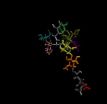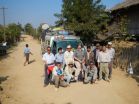(Press-News.org) September 12, 2014 -- Humanitarian crises are becoming increasingly complex and a growing threat to the health and safety of populations. An improved evidence-base to guide interventions in the countries most vulnerable to these conditions is more critical than ever. A paper by researchers at Columbia University's Mailman School of Public Health published online in the journal Science, looks at the challenges of doing research in such settings and the strategies that must be adopted for scientific advance.
"The circumstances of humanitarian crises present many barriers to the conduct of scientifically rigorous research, and yet it is these same circumstances that make a solid evidence base so crucial for health programming in these settings," said Alastair Ager, PhD, professor of Population and Family Health.
While there have been notable advances in immunization programs and treatment of acute malnutrition over the years, the evidence base for many other current practices remains weak. Lack of data constrains ongoing research. Even when relevant data are present, the breakdown of health information systems and displacement of populations can often mean there is little access to the data. In cases where data is accessible, there is often a lack of incentive for the sharing of information.
The process of bringing together researchers and program managers from academia and humanitarian organizations across continents for a new research funding initative led to formulating the five following themes for scientific advancement, all critical to progress in the field of humanitarian response:
Better use of evidence from non-humanitarian settings
Development of robust methodologies appropriate to crisis settings
Identifying ethical bases for considering the consequences for those not receiving a particular intervention
Engaging local participation to ensure cultural adaptation and that specific demands of a humanitarian context are addressed with a contextual sensitivity
Establishing effective engagement with research institutions from low- and middle-income countries to making data available to as broad a community as possible
"Although many health risks in the aftermath of disasters or conflict are predictable and minimum best practice interventions have already been established, health needs can evolve rapidly, and we must be ready with adaptable program strategies," said Ager.
INFORMATION:
About Columbia University's Mailman School of Public Health
Founded in 1922, Columbia University's Mailman School of Public Health pursues an agenda of research, education, and service to address the critical and complex public health issues affecting New Yorkers, the nation and the world. The Mailman School is the third largest recipient of NIH grants among schools of public health. Its over 450 multi-disciplinary faculty members work in more than 100 countries around the world, addressing such issues as preventing infectious and chronic diseases, environmental health, maternal and child health, health policy, climate change & health, and public health preparedness. It is a leader in public health education with over 1,300 graduate students from more than 40 nations pursuing a variety of master's and doctoral degree programs. The Mailman School is also home to numerous world-renowned research centers including ICAP (formerly the International Center for AIDS Care and Treatment Programs) and the Center for Infection and Immunity. For more information, please visit http://www.mailman.columbia.edu
Advancing the science for health programming in crisis conditions
2014-09-15
ELSE PRESS RELEASES FROM THIS DATE:
Decoding 'sweet codes' that determine protein fates
2014-09-15
VIDEO:
Here are movies of dynamic behavior of a sugar chain on the basis of NMR-validated simulations. This chain has a particular sugar (green circle).
Click here for more information.
We often experience difficulties in identifying the accurate shape of dynamic and fluctuating objects. This is especially the case in the nanoscale world of biomolecules. The research group lead by Professor Koichi Kato of the Institute for Molecular Science, National Institutes of Natural Sciences ...
You don't walk alone
2014-09-15
65 million people around the world today suffer from epilepsy, a condition of the brain that may trigger an uncontrollable seizure at any time, often for no known reason. A seizure is a disruption of the electrical communication between neurons, and someone is said to have epilepsy if they experience two or more unprovoked seizures separated by at least 24 hours.
Epilepsy is the most common chronic disease in pediatric neurology, with about 0.5% of children developing epilepsy during their lifetime. A further 30% of epileptic children develop refractory ...
Walking or cycling to work improves wellbeing, University of East Anglia researchers find
2014-09-15
Walking or cycling to work is better for people's mental health than driving to work, according to new research by health economists at the University of East Anglia and the Centre for Diet and Activity Research (CEDAR).
A report published today reveals that people who stopped driving and started walking or cycling to work benefited from improved wellbeing. In particular, active commuters felt better able to concentrate and were less under strain than if they travelled by car.
These benefits come on top of the physical health benefits of walking and cycling that are ...
Nature: New drug blocks gene driving cancer growth
2014-09-15
When active, the protein called Ral can drive tumor growth and metastasis in several human cancers including pancreatic, prostate, lung, colon and bladder. Unfortunately, drugs that block its activity are not available. A study published today in the journal Nature uses a novel approach to target the activation of these Ral proteins: "When you want to keep an alligator from biting you, you can tie its mouth shut. We took another approach – we put a stick in its mouth to hold it open," says Dan Theodorescu, MD, PhD, professor of Urology and Pharmacology, director of the ...
Blood-cleansing biospleen device developed for sepsis therapy
2014-09-15
Things can go downhill fast when a patient has sepsis, a life-threatening condition in which bacteria or fungi multiply in a patient's blood -- often too fast for antibiotics to help. A new device inspired by the human spleen and developed by a team at Harvard's Wyss Institute for Biologically Inspired Engineering may radically transform the way doctors treat sepsis.
"Even with the best current treatments, sepsis patients are dying in intensive care units at least 30 percent of the time," said Mike Super, Ph.D., Senior Staff Scientist at the Wyss Institute. "We need ...
Muscular dystrophy: Repair the muscles, not the genetic defect
2014-09-15
ANN ARBOR, Mich.---A potential way to treat muscular dystrophy directly targets muscle repair instead of the underlying genetic defect that usually leads to the disease.
Muscular dystrophies are a group of muscle diseases characterized by skeletal muscle wasting and weakness. Mutations in certain proteins, most commonly the protein dystrophin, cause muscular dystrophy in humans and also in mice.
A University of Michigan team led by cell biologist Haoxing Xu, discovered that mice missing a critical calcium channel inside the cell, called TRPML1, showed similar muscle ...
Three's a charm: NIST detectors reveal entangled photon triplets
2014-09-15
BOULDER, Colo – Researchers at the University of Waterloo in Canada have directly entangled three photons in the most technologically useful state for the first time, thanks in part to superfast, super-efficient single-photon detectors developed by the National Institute of Standards and Technology (NIST).
Entanglement is a special feature of the quantum world in which certain properties of individual particles become linked such that knowledge of the quantum state of any one particle dictates that of the others. Entanglement plays a critical role in quantum information ...
The Lancet: Some lung cancer patients could live longer when treated
2014-09-15
Treating advanced small-cell lung cancer (SCLC) with thoracic (or chest) radiation therapy in addition to standard treatment significantly prolongs long-term survival and reduces cancer recurrence in the chest by almost 50%, according to new research published in The Lancet and being presented simultaneously at ASTRO's 2014 Annual Meeting in San Francisco.
The authors say that as the thoracic radiotherapy is well tolerated, it should to be routinely offered to all SCLC patients with extensive disease whose cancer responds to chemotherapy.
SCLC is an aggressive cancer ...
Researchers find neural compensation in people with Alzheimer's-related protein
2014-09-15
Berkeley — The human brain is capable of a neural workaround that compensates for the buildup of beta-amyloid, a destructive protein associated with Alzheimer's disease, according to a new study led by researchers at the University of California, Berkeley.
The findings, to be published Sunday, Sept. 14, in the journal Nature Neuroscience, could help explain how some older adults with beta-amyloid deposits in their brain retain normal cognitive function while others develop dementia.
"This study provides evidence that there is plasticity or compensation ability in ...
Asian monsoon much older than previously thought
2014-09-15
The Asian monsoon already existed 40 million years ago during a period of high atmospheric carbon dioxide and warmer temperatures, reports an international research team led by a University of Arizona geoscientist.
Scientists thought the climate pattern known as the Asian monsoon began 22-25 million years ago as a result of the uplift of the Tibetan Plateau and the Himalaya Mountains.
"It is surprising," said lead author Alexis Licht, now a research associate in the UA department of geosciences. "People thought the monsoon started much later."
The monsoon, the largest ...






